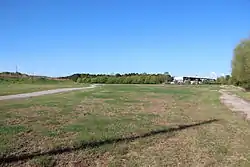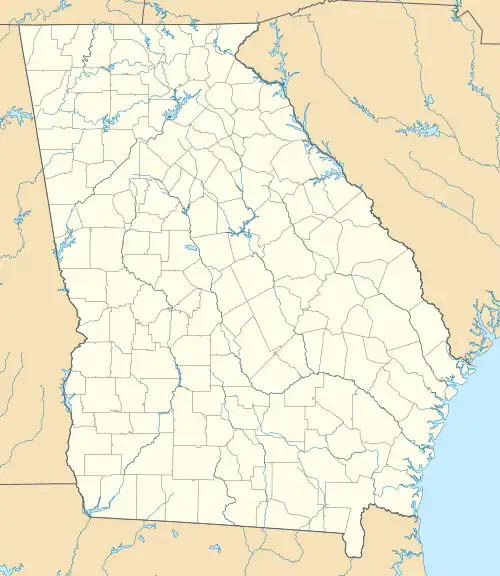 Leake Mounds site in 2015 | |
 Location within Georgia today | |
| Location | Cartersville, Georgia, Bartow County, Georgia, |
|---|---|
| Region | Bartow County, Georgia |
| Coordinates | 34°8′21.55″N 84°50′46.03″W / 34.1393194°N 84.8461194°W |
| History | |
| Founded | 300 BCE |
| Abandoned | 1500 CE |
| Periods | Middle Woodland, Lamar phase |
| Cultures | Swift Creek Culture, South Appalachian Mississippian culture |
| Architecture | |
| Architectural details | Number of temples: 3 |
Leake Mounds (9BR2) is an important archaeological site in Bartow County, Georgia built and used by peoples of the Swift Creek Culture. The site is 2 miles (3.2 km) west of the well-known Etowah Mounds on the Etowah River. It predates that site by hundreds of years.
Excavation of nearly 50,000 square feet (4,600 m2) on the site showed that Leake Mounds was one of the most important Middle Woodland period site in this area from around 300 BCE to 650 CE. It was a center with ties throughout the Southeast and Midwest. It was abandoned about 650 CE. It was not occupied again for nearly nine hundred years, until about 1500, by different peoples near the end of the Mississippian culture period.[1]
The site includes at least three major platform mounds and a large semi-circular moat/ditch. While much of the mounds were razed to be used as road fill for the expansion of the Georgia State Route 113 and Georgia State Route 61 in the 1940s, significant portions of the site remain. Several sites on nearby Ladds Mountain were integrally associated with Leake, including Shaw Mound, a stone burial mound; Indian Fort, a stone wall enclosure; and Ladds Cave, a large cave.
Examples of a type of pottery decoration consisting of a diamond-shaped checks found at Leake Mounds are also known from Hopewell sites in Ohio (such as Seip, Rockhold, Harness, and Turner), the Mann site in southern Indiana. This style has also been found on pottery at other sites in the South, such as the Miner's Creek site, 9HY98, and Mandeville site in Georgia, and the Yearwood site in southern Tennessee.[2]
See also
References
- ↑ "What is the Leake site and why is it significant?". Southern Research, Historic Preservation Consultants, Inc.
- ↑ "Excavation and Archaeological Investigation at Bartow County's Leake Site-Evidence for Interaction". Archived from the original on 2011-07-07. Retrieved 2010-01-03.
External links
- Excavation and Archaeological Investigation at Bartow County's Leake Site
- Bartow County Georgia Profile and Information Guide
- The Woodland Period Cultural Landscape of the Leake Site Complex: Encompassing the Diversity of Human Action
- THE MANN SITE AND THE LEAKE SITE : LINKING THE MIDWEST AND THE SOUTHEAST DURING THE MIDDLE WOODLAND PERIOD

